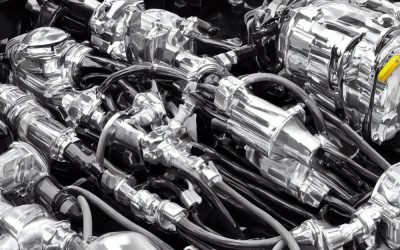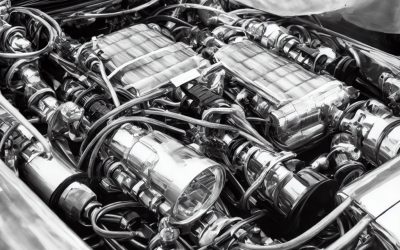In the intricate world of automotive engineering, few advancements have had as profound an impact as the evolution of fuel injection systems. For decades, the humble carburetor reigned supreme, a mechanical marvel that mixed air and fuel for combustion. However, as demands for efficiency, performance, and reduced emissions grew, a more precise and sophisticated method was needed. This led to the gradual, yet revolutionary, adoption of fuel injection – a technology that has transformed how vehicles run, from early mechanical marvels to today’s highly advanced electronic systems. This blog post will delve into the fascinating history of automotive fuel injection, tracing its journey from nascent concepts to the ubiquitous technology it is today.
The Dawn of Precision: Early Concepts and Mechanical Systems
The idea of injecting fuel directly into an engine isn’t as new as one might think. As early as 1872, George Bailey Brayton, an American mechanical engineer, patented an internal combustion engine that utilized a pneumatic fuel injection system, known as air-blast injection [1]. This early concept, though rudimentary, laid some foundational groundwork. Rudolf Diesel, the inventor of the diesel engine, later adopted and improved upon Brayton’s air-blast injection system in 1894, increasing the air blast pressure significantly [1].
A significant step forward in practical application came in 1891 with the British Herbert-Akroyd oil engine. This engine employed a pressurized fuel injection system using a ‘jerk pump’ to deliver oil at high pressure to an injector, a design often referred to as a hot-bulb engine [1]. These early systems, primarily for diesel engines, were complex but demonstrated the potential for improved fuel delivery over carburetors.
For gasoline engines, the journey was slower. While the concept of direct injection for gasoline engines was explored, its widespread adoption was hindered by complexity and cost. The first production car to use direct fuel injection was the 1925 Hesselman engine [1], but it was still a niche application.
World War II and the Rise of Direct Injection in Aircraft
World War II proved to be a crucible for fuel injection technology, particularly for aircraft engines. German fighter aircraft, such as those powered by the Daimler-Benz DB 601 and BMW 801 engines, utilized direct fuel injection systems [1]. These mechanical pump systems injected fuel directly into the combustion chamber, offering crucial advantages at high altitudes and during aggressive maneuvers, where carburetors struggled with fuel starvation and icing. The superior performance of these fuel-injected aircraft engines highlighted the technology’s potential, paving the way for its eventual transition to automotive applications after the war.
One of the most notable early examples of direct injection in a petrol-engined production car was the iconic 1954 Mercedes-Benz 300 SL [1]. This vehicle featured a modified Bosch mechanical direct injection system, originally designed for diesel engines. While complex and expensive, it delivered significant power and efficiency gains, cementing fuel injection’s reputation as a performance enhancer.
The Era of Manifold Injection: A Stepping Stone to Widespread Adoption
Despite the performance benefits of direct injection, its complexity and cost made it impractical for mass-market passenger cars in the post-war era. This led to the development and widespread adoption of manifold injection systems. In these systems, fuel is injected into the intake manifold, either at a single central point (single-point injection) or near each intake valve (multi-point injection) [1]. This approach was simpler and more cost-effective to implement than direct injection.
Early manifold injection systems were predominantly mechanical. A prime example is the Bosch K-Jetronic system, introduced in 1974 [1]. This continuous injection system used a mechanical fuel distributor to precisely meter fuel to each cylinder. K-Jetronic represented a significant leap forward from carburetors in terms of fuel economy and emissions control, and it was widely adopted by European car manufacturers throughout the 1970s and 1980s.
Single-point injection, also known as throttle-body injection, emerged as a relatively low-cost solution for automakers to meet tightening exhaust emissions regulations in the 1980s and early 1990s [1]. It utilized a single injector mounted in a throttle body, similar to a carburetor. While less precise than multi-point injection, it offered improved driveability and reduced emissions compared to carburetors, making it a popular choice for many American-made passenger cars and light trucks during that period.
The Digital Revolution: Electronic Fuel Injection (EFI) Takes Over
The true paradigm shift in automotive fuel injection occurred with the advent of digital electronics in the 1980s. The development of affordable and powerful Engine Control Units (ECUs) revolutionized fuel delivery. ECUs allowed for unprecedented precision in controlling fuel delivery, ignition timing, and other critical engine parameters [1]. This marked the beginning of the widespread adoption of Electronic Fuel Injection (EFI) systems.
Initially, single-point EFI systems were common, offering a cost-effective way to meet emissions standards. However, multi-point EFI (port injection) quickly became the dominant technology. By injecting fuel directly into the intake port just before each cylinder’s intake valve, multi-point systems provided superior fuel atomization and more precise control over fuel delivery, leading to improved performance and efficiency [1].
The 1990s brought further refinements with the introduction of sequential multi-port injection. In this system, fuel is injected just before the intake valve opens for each cylinder, optimizing fuel delivery for each individual combustion event. This advancement further enhanced fuel efficiency and significantly reduced emissions, solidifying EFI’s position as the industry standard.
The Modern Era: Gasoline Direct Injection (GDI) and Common Rail
The 21st century has witnessed another significant evolution in fuel injection technology, particularly with the rise of Gasoline Direct Injection (GDI) for petrol engines. GDI systems inject fuel directly into the combustion chamber, much like the early diesel and aircraft systems [1]. This direct injection allows for even greater precision in fuel delivery, enabling higher compression ratios and resulting in improved fuel economy and power output. Many modern engines now combine GDI with port injection (dual injection systems) to optimize performance across a wider range of engine speeds and loads.
For diesel engines, the common-rail system has become the industry standard. In a common-rail system, a high-pressure pump maintains a constant fuel pressure in a shared rail, from which electronically controlled injectors deliver fuel directly into the cylinders [1]. This technology offers unparalleled control over injection pressure, timing, and the ability to perform multiple injection events per combustion cycle. The benefits are substantial: significant improvements in fuel efficiency, reduced emissions, and quieter engine operation.
Conclusion
The history of automotive fuel injection is a compelling narrative of continuous innovation driven by the relentless pursuit of better efficiency, enhanced performance, and reduced environmental impact. From the rudimentary mechanical systems of the late 19th century to the sophisticated electronic and common-rail technologies of today, fuel injection has fundamentally reshaped the automotive landscape. It has played a pivotal role in making modern vehicles more powerful, more fuel-efficient, and cleaner than ever before, a testament to the ingenuity of automotive engineers throughout history.
References
[1] “Fuel injection – Wikipedia.” [https://en.wikipedia.org/wiki/Fuel_injection](https://en.wikipedia.org/wiki/Fuel_injection). Accessed 23 July 2025.




